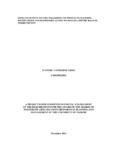| dc.description.abstract | Construction sites are dusty places, especially in dry weather conditions. According to
Greater London Authority and London Councils’ best Practice Guidance (The control of
dust and emissions from construction and demolition 2002), poor air quality can damage
health and impact upon quality of life. It further states that in 2005 it was predicted that
approximately 1,000 accelerated deaths and 1,000 extra respiratory hospital admissions
occurred in London as a result of PM10 air pollution. Giakanja Tetu Mission Road
(D434), Kagogi-Ihwa-Ihururu Road (E1690) and Wandumbi- Kigogoini Road (E53) in
Nyeri County in Kenya are roads that the government of Kenya upgraded from gravel to
bitumen Standard between 2011- 2013 through Kenya Rural Roads Authority (KeRRA).
An environmental impact assessment conducted by consultants in 2012 on the same
project identified dust emissions and air mass contaminants as possible negative impacts
of the project.
This study intended to establish whether dust emissions were experienced during the
construction phase of the road and their effects on the learning institutions and
businesses located within 500 Metres on both sides of the road.
The study was conducted within a section of the road between the market centres of
Wamagana and Ihithe with an approximate length of four and a half Kilometres. The
specific objectives of the study were (a) to establish whether dust was generated during
the construction of the road based on the attitude of business owners and heads of
learning institutions, (b) to assess whether weather conditions during the construction of
the road influenced the amount of dust generated during the construction of the road
based on the attitude of business own
additional data from all the Health Centres located within the study area.
Results from business owners and heads of learning institutions indicated that dust was
generated during the road construction and it was more than before the road construction
started. The activity that generated more dust was the laying of gravel followed by
transportation of soil while excavation produced the least dust. 72.5% of the businesses
studied indicated that dust generated during the road rehabilitation led to loss of business
while 27.5% indicated that they did not incur any loss. According to heads of learning
institutions and business owners, dust generated during the road construction lead to
respiratory problems, eye irritation/ problems, staining of walls and interruption of
school activities and constant absence of members of staff and students due to health
related problem
The study, therefore, recommends that authorities that are charged with the responsibility
of enforcing mitigation measures against dust generated from road construction to do so
during construction of roads and the project proponent together with the contractors in
road construction projects should ensure mitigation measures recommended in
Environmental and social Impact assessments are implemented. Awareness should be
created by NEMA to people living within road project areas and who are likely to be
affected by construction activities on their right to clean and healthy environment and
how to seek legal redress incase of pollution of their environment. | en_US |

